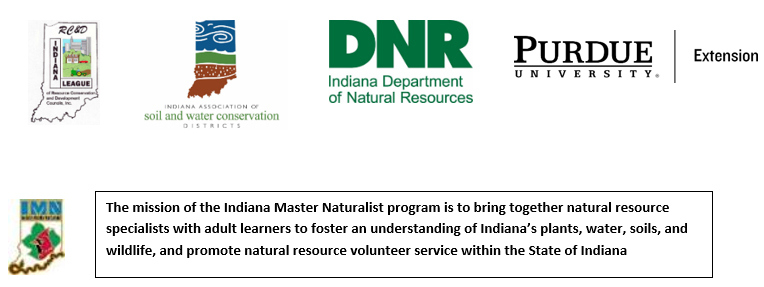IMNature
The Newsletter for IMN Hosts and certified graduates
2024 Autumn Edition
 |
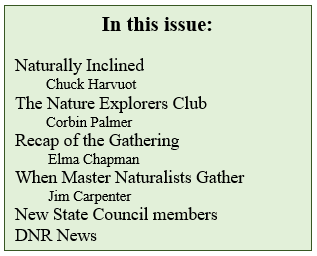
What a great state gathering we had in Allen County. Despite a few weather-related issues, most of the scheduled program went smoothly. The topics were interesting, the speakers were well informed, the hikes were fun, the woodcarving was fascinating, and the camaraderie was delightful. Russ Voorhees and his committee deserve a big thank you for their time and effort on our behalf. I particularly enjoyed Dr. Kingsbury’s presentation on Indiana reptiles and amphibians during Saturday afternoon’s session. It reminded me of an article I had started to write several months ago but had never finished, so, I dug it out.
As you might recall, during the last few days of December 2023 and the first several days in January 2024, we had some unseasonably warm weather. It was so warm I even mowed my lawn. Of course, that warm weather didn’t last long. The first day we returned to winter conditions, the temperature dropped dramatically, and sub-freezing temperatures were expected that night. On my last trip outside that evening with my dog, she stopped to investigate something. Molly has a penchant for smuggling some rather unsavory things into the house in her mouth, so I had to check what had caught her attention. It was a toad. What was a toad doing out in January? Whatever the reason, I definitely didn’t want Molly to have a toad in her mouth. Describing it as lethargic would have been optimistic. I wasn’t sure if it was even alive. If it was, it certainly didn’t look like it had enough energy to hop, let alone burrow. So, I got a box and took it inside. When I checked on it the next morning, it was sitting in a corner, looking up at me. Since the forecast was for more winter weather, I figured I had a new boarder.
I’ve mentioned before that I had a wide variety of pets when growing up, but a toad was never one of them. When I was in elementary school my best friend Rob had warned me that handling toads would give you warts—and best friends don’t lie to you. Especially since Rob reminded me that he had gone to summer camp and learned “lots of stuff” like that. Regardless of Rob’s warning, I had a toad and felt compelled to do something more than keep it in a small cardboard box. I brought an empty 10-gallon aquarium in from the garage, dug up enough turf to cover the bottom of the tank, watered the grass, added some dried leaves, and when the tank had warmed up sufficiently, put the toad in it.
I didn’t really know a lot about toads at that point, although I had learned many years ago that Rob had been wrong about the warts. I also knew they eat a lot of bugs and that dogs should not have toads in their mouths. So, I decided to find out what else I needed to know to keep this guy until warmer weather arrived.
There are two types of toads native to Indiana: the American toad, Anaxyrus americanus, and the Fowler’s toad, Anaxyrus fowleri. They share many of the same characteristics: both are carnivorous, nocturnal, and have parotoid glands behind their eyes which produce a milky, toxic liquid to deter predators. While that liquid doesn’t protect them from garter and hognose snakes, you definitely don’t want your dog to eat one. Toads don’t have teeth; instead, they swallow their prey whole and will eat about anything they can get in their mouth. They can eat hundreds of insects a day and live between five and 10 years. Both types have dry, warty skin, which when shedding the toad will swallow. A toad drinks through its belly by sitting in a wet spot and letting the water soak in through its skin. They like loose soil and leaves and in the winter burrow down below the frost line where go through brumation, the cold-blooded version of hibernation. Mating usually occurs during the evening or at night in, or near, shallow water. A female toad can lay up to 2,000 eggs in a string up to 60 inches long that looks like spaghetti. Toad tadpoles hatch in three to 12 days and can secrete a chemical powerful enough that eating one can kill a fish.
|
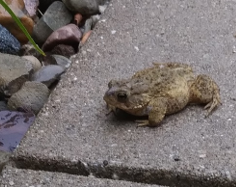
Although they share many traits, there are differences. The American toad is one of the most common and widely known species of toad. They are a little larger than Fowler’s toad, usually between 2.5 and 4” long, (females are larger than males), and have many warts present all over the back and legs. Their coloring is usually brown to gray, or olive, with patches of yellow, buff, or other light colors, with dark spots. They have small dark spots on their chest and abdomen. Their call is a trilling noise that can last for up to 20 seconds. The Fowler’s toads are slightly smaller, about 2-3 inches long, are gray to brownish green or olive, with dark splotches on the back that have three or more warts in them; their belly is usually white or yellowish.
This toad had a speckled belly, so I figured it was an American toad. During some errands later that day, I stopped at a local pet shop and purchased a dozen crickets, which I put in the tank with the toad. When I checked on the toad that evening, all of them were gone. I probably should not have been surprised, since I had been forewarned about their appetite. At $2 for a dozen crickets each day, the potential cost of keeping this guy for a few months seemed a bit expensive, so an all-you-can-eat buffet was not going to happen. I discovered I could reduce the cost by purchasing larger quantities, and an article on keeping toads as pets recommended meal worms, so I got into a pattern of a few crickets one day and some meal worms the next. Other than feeding, the toad was fairly low-maintenance. The tank was near a window, but not in direct sunlight. I’d water the grass once a week and mist it every couple of days. I made sure there was water in the water dish which frequently became dirty.
Being nocturnal, it wasn’t very active during the day. It had a couple of small depressions in the grass that it liked to sit in with only a portion of its head being visible. Sometimes I didn’t see it at all. On one occasion, after searching for it for a few minutes, I finally lifted the aquarium and looked at the bottom glass to find where it was hidden. Eventually spring arrived and on an evening in early May, I released it in my pollinator garden. It sat for a while, then hopped away—without thanking me. I’ve seen a toad on my front walk at night a few times since then but have no way of knowing if it’s the same one. Regardless, I keep Molly away from the ones we see, and hope that this winter the toad stays in its burrow until the spring.
|
 |
PS. Ooops!!! Since releasing the toad, I learned that, despite my good intentions, what I did was illegal. There’s a rule governing reptiles and amphibians that prohibits them from being released back into the wild, unless: They are released within 30 days of capture, are released at the capture site, are not housed with another reptile or amphibian, or a permit is issued by the DNR to do so. The reason for this is the potential spread of parasites or diseases that can spread to wild populations when a reptile or amphibian is housed in captivity for a long time and then later released into the wild. So, since I kept the toad for several months, I should have kept the toad for the rest of its life or given it to a nature center that would be willing to keep it year-round. I’ll know better next time!
For more information on regulations relating to amphibians and reptiles visit https://www.in.gov/dnr/fish-and-wildlife/nongame-and-endangered-wildlife/indianas-reptile-and-amphibian-regulations/

The Nature Explorers Club
By Corbin Palmer
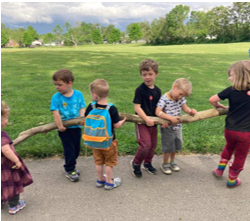
Over the past four years a family-oriented outdoor education club has been spreading throughout Indiana, inspiring children and adults to go out and explore. The Nature Explorers Club was created by Breanna Fields in Columbus. Fields is a former teacher and outdoor enthusiast. She is well on her way to becoming an Indiana Master Naturalist.
The focus of Nature Explorers Club is to give both children and parents a way to make connections and access an outlet for creativity and learning outdoors. Fields said the goal of the club is to inspire the next generation of naturalists and nature lovers; to help people get outdoors without fearing what’s out there, and embrace nature and get excited about going out and getting dirty.
“It is all about nature and its importance: why we need to be outside, why we’re drawn to it. The more you know, the more you can appreciate,” Fields said.
Each week, the club meets outdoors to learn about a different topic that relates to nature, such as the seasons, moon phases, or climate. The classes begin with a circle time, where everyone sits together to sing a song, read a book and have a discussion related to that day’s topic.
The group then gets to stretch their legs on a short hike, usually with some goal in mind: to look for or collect things related to the lesson, Fields explained. A themed treat or snack is offered after meeting back up from the hike. While snacking, a journal prompt is given to the class for all ages to reflect on the lesson. The class wraps up with one more planned activity, sometimes a game, other times an art or science project.
Fields reflected on witnessing her vision for the club come to life during the hiking portion of an early class in Noblitt Park in Columbus. “During the hike,” she said, “it's just a time where kids can explore and enjoy the woods without strict rules to follow. Basically, our only rules are to respect everyone around you and be in sight of your parents.” According to Fields, the children get a lot of freedom during this time—most parents talk and give their kids some space to play and enjoy being in the woods.
|
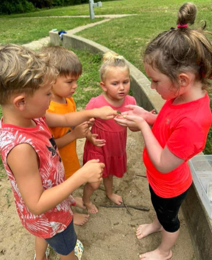
“So this one time, I was standing there with my friend looking around at all of the kids, and I just thought, ‘Man, this is what I wanted, what I envisioned, when I first started this class.’”
She described a wide scene of all the children being themselves: one group was skipping rocks over nearby water, while others were digging in the sand on the bank. Another few were assembling a woodland fort, and some were even pretending to be pirates atop a downed log, dueling with sticks that they imagined as swords, yelling pirate phrases like “swashbuckler” and “walk the plank.”
“This is what we want,” said Fields, “our kids to be outside, enjoying all that nature has to offer.”
This fall marks the fourth year of Nature Explorers Club. It all began during COVID, after Fields’ daughter was born and her son turned three. She said she was putting together some at-home preschool materials for her son, because of all the uncertainties of the pandemic, and one of the things she wanted to do was a nature study. Fields thought since it would be outside that it would be fun to include some friends and their children for the study. They began meeting once a week, and before long, Nature Explorers Club was officially born.
“At first there were five of us, then the next season there were more that were interested,” Fields said. “It just blossomed from there.”
|
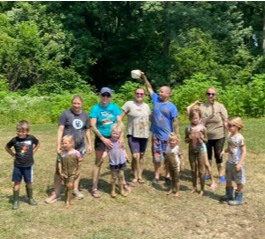
Each season the class grew. Fields eventually began teaching a second class, and a third was added later with another parent as the class leader. Now, four years in, Nature Club offers two baby classes specifically designed for kids under two, as well as mixed-age classes. This season, there are 12 total classes running across Indiana in Columbus, Bloomington, Madison, Seymour, Trafalgar, Greenwood, and Indianapolis.
Fields emphasized her appreciation for all the leaders around the state who help bring Nature Explorers Club to life each week, as well as for all the families who have signed up for classes. Without their support, she said, Nature Explorers Club wouldn’t survive. As Nature Club continues to grow, more information about future classes or new class leader opportunities can be found on their website, natureexplorersclub.godaddysites.com, or on the Nature Explorer’s Club Facebook page. Fields can be reached at breanna.mynatureclub@gmail.com.
|
The Gathering 2024
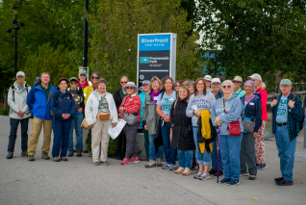
If you missed it, you missed a great time. The only loss due to weather was the cancellation of the canal boat river tour on the Sweet Breeze due to strong winds, but the cost will be refunded to those who signed up for it. The hike through Promenade Park and The Landing historic district went on as scheduled. It was interesting to hear about the old buildings, the canal, and the history of the area.
|
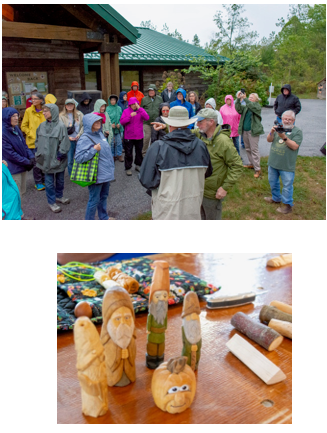
Later Friday evening we had a program at Fox Island County Park on the effects of the 2022 derecho. After a slide show detailing the devastation at the park (it was closed for almost two years!) and the amazing restoration work, we did a hike on the property. It was sprinkling when we started but transitioned to about three minutes of heavy rain and wind (Thanks, Helene!) before going back to sprinkling. But it didn’t dampen our spirits—IMNs are tough! A lot of lucky attendees went home with a special gift: a hand-carved wood spirit made from some of the fallen wood at the park left over from the derecho.
Saturday was filled with programs and hikes. We met at the LC Nature Park in Roanoke, just southwest of Fort Wayne. If you’ve never heard of it, it may be because this nature center is quite new; it opened in 2019. The nature center is located in the Little River Valley which extends from Fort Wayne to Huntington.
|
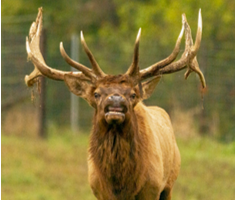
The park is 200 acres and contains both prairie and forest habitats. It also has an elk herd and a bison herd. Because of this, the park is only open to scheduled visits and events, except on a few special fundraising days during the year when hikes are not guided, but enough volunteers staff the area to provide for the safety of both visitors and animals. While we were there, the elk were in rutting season and were bugling. What a strange sound! I expected a deeper, more majestic sound, but it was more of a squeal. It definitely carried a long distance.
|
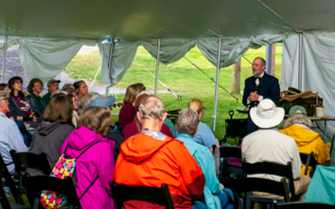
We had a hike around the property and had three programs: one about bats in Indiana, one on amphibians and reptiles of Indiana, and finally, an historical reenactment by Bob Dispenza, who portrayed a canal boat captain from 1878. During his presentation, we learned about the trials and tribulations of canal boat life, the way a lock works for raising or lowering the boats to the water level on either side of the lock, and the demise of canals after losing the race with railroads to deliver merchandise quickly and cheaply. Canals were short-lived. They began in 1848 and by the 1870s the railroads had taken a lot of their business.
|
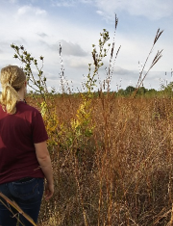
Before the railroads, canals were much cheaper than moving goods on land. Canal boats hauled people as well as flour, wheat, beans, whiskey, oysters, clams, cheese, cotton, tobacco, agricultural equipment, and “everything from cradles to tombstones.” Indiana was the last state where canals were constructed. In 1913 there was a major flood caused by snow melt and heavy rains that destroyed most canals in Indiana and Ohio.
After the official end of the Gathering, there were still post-events for those who cared to stay longer. We hiked at Arrowhead Prairie, a property close to LC Nature Park and part of the Little River Wetlands Project. It has a chimney swift tower, but unfortunately for us, the swifts had already gone south for the winter. The preserve is a beautiful prairie and at this time of year it was covered in goldenrod and New England asters, a medley of gold and purple. We also saw partridge pea blooming and the seed pods of indigo, cup plants, and compass plants. Also, we saw a lot of butterflies and an eagle!
|
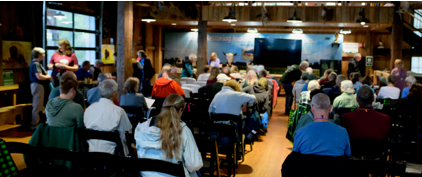
Yet another hike awaited us when we arrived at Eagle Marsh. Here we walked out to the berm that divides the St. Mary’s River watershed from the Wabash River watershed. At flood stage the two watersheds are connected and the berm was built to keep the invasive Asian carp out of the Great Lakes. There is still a channel to allow floodwaters to cross, necessary to keep Fort Wayne from flooding in severe weather, but it has a chain link fence to keep the carp out. If the carp get into the Great Lakes, they will devastate the fishery there.
|
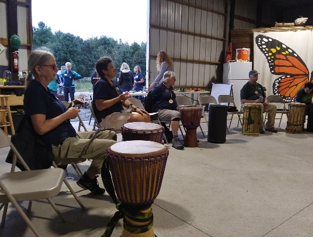
After the hike we relaxed around a campfire, made s’mores, and participated in a drum circle. There were at least twenty drums available to play as well as other percussion instruments, like things to shake and rattle, mostly made from natural or recycled materials. A leader set the beat and different groups were instructed in different rhythms to play. It was an enjoyable end to a great day of activities.
The last activity was on Sunday morning. We visited the Chief Richardville house in Fort Wayne. The house has been restored on the exterior, but most of the interior was not. The best part of the tour was listening to one of Chief Richardville’s descendants about their traditional ways. The descendant told us cattails were their Walmart—they were used for food, medicine, and building materials by weaving them into mats. The Miami people had 30 words for different kinds of corn. They recently discovered their squash at Monticello, Jefferson’s home. It was labeled Wabash squash. They also recently found wild rice growing in Indiana.
Finding these connections to their elders has been very rewarding to Chief Richardville’s descendants. He was wealthy because his mother owned the land that was the portage between the St. Mary’s River and the Little River. This allowed him to provide for many of the indigenous people before they were forcibly removed to Oklahoma.
The Gathering was a great learning experience. It had lots of exercise, and plenty of time spent with old friends and new. If you missed it, don’t despair: the 2025 Gathering will be April 4-6 centered around Brown County State Park. Camping will be available, or you can make a reservation at the Abe Martin Lodge in the park or at one of the nearby hotels in Nashville. Details will be forthcoming soon. We hope to see you there!
|
2025 IMN Gathering
Our next Gathering will be held at Brown County State Park and surrounding areas, April 4-6, 2025.
There will be pre and post optional activities. The main Gathering will be Friday evening to Saturday. There are many hotels around the park. If interested in staying at the park, camping will be available or you can stay at Abe Martin Lodge. The lodge has held some rooms for us, when booking you can use the group code 0404IN.
When Master Naturalists Gather
Another year, another Gathering.
Each one is so unique.
Attended by like-minded people.
All fulfilling the same basic need.
This poem is intended for only one page,
so I'll be brief in what I say.
But what makes a Gathering special to me,
are the memories I make on that day.
The educators and presenters,
are an awesome part of our time
But in among the breaks and the snacks,
our group of individuals combine.
I think perhaps what might be true,
and this is my theory so far:
We naturalists as a general rule,
can appreciate things as they are.
Accepting the reality of nature,
and its weave of natural selection
Opens our hearts to the uniqueness of people,
allowing for mutual connection.
So we Gather, and visit as we learn..
and enjoy the company of others.
And for a weekend the naturalists become,
much like sister and brother.
Jim Carpenter 2024
This was written after the 2024 Gathering had just ended. As usual among my 'fact' oriented takeaways were a lot of 'heart' takeaways from spending time with so many old and new friends. |
|
 |
New State Council Members
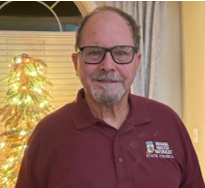
John Sohn: I had my first 10-mile hike as a child in Brown County in 1962 and I’ve been involved with the outdoors ever since. I own classified forest land in Brown County today, and I have been a steward of my land taking out invasive plants and encouraging wildlife habitat.
I am an Indiana Master Naturalist, Master Gardener, Board member of the Brown County Native Woodland Project, and active member of the Friends of Brown County State Park.
Since retirement I have been involved with many weed wrangles and outdoor training sessions. I was elected to serve on the Indiana Master Naturalist State Council in August 2024.
|
.........

Krista Daniels: I am the Interpretive Naturalist Manager at Elkhart County Parks. I am a graduate of Goshen College and have made Goshen my home. My husband and I have two children, one dog and three cats. I love gardening, hiking and working with children.
I have been with the parks for 23 years and love it just as much as I did that very first year. In addition to leading school programs, public programs and events, I have enjoyed being an active part of the IMN program in Elkhart County. I have hosted Jr. and Teen IMN programs and every year help plan our adult IMN class. I am very excited to continue with this amazing program as a member of the State IMN Council and I look forward to being a part of its support and growth for years to come.
|
DNR News
Project hopes to restore Franklin’s ground squirrels to native range
The DNR, The Nature Conservancy (TNC), and Purdue Fort Wayne (PFW) have teamed up to return Franklin’s ground squirrels to their native Indiana range, starting with a population at Kankakee Sands nature preserve. Franklin’s ground squirrels were once found throughout northwest Indiana’s prairies, but the species lost most of its habitat as agriculture advanced. It was listed as state endangered in 1993. Today, the squirrel’s environment has been fragmented, which exposes it to more negative environmental pressures including predation, vehicle strikes, and loss of genetic diversity.
That’s why the DNR, TNC, and PFW selected TNC’s Efroymson Prairie at Kankakee Sands to establish the first translocated population. The site’s short-grass prairie offers the space the ground squirrels need to spread out and thrive. “The Nature Conservancy has been creating prairie habitat at Kankakee Sands for more than 25 years,” said Trevor Edmonson, project director for the site. “The bison herd we brought to the site in 2016 have greatly improved the prairie with their selective grazing habits. The time was right to bring in the Franklin’s ground squirrel to take advantage of the improved prairie.
PFW researchers collected 25 Franklin’s ground squirrels from South Dakota. The squirrels underwent a vet inspection and a 30-day quarantine prior to entering acclimation enclosures and being released at Kankakee Sands. Some of the Franklin’s ground squirrels were equipped with GPS collars to monitor their movements, habitat selection, and survival. This relocation is part of a larger effort to reestablish Franklin’s ground squirrels in their native range. All three partners are establishing small groups of Franklin’s ground squirrels on managed properties across the area and will monitor their survival in upcoming years.
This work is just one project to help state endangered mammals in Indiana. To learn more, visit DNR’s mammals page by going to on.IN.gov/wildlife, clicking on “nongame and endangered wildlife” and then “mammals.” To donate to help fund similar efforts, please see on.IN.gov/nongamewildlifefund.
The Indiana Master Naturalist program is sponsored by the Resource Conservation & Development Councils, Indiana Soil & Water Conservation Districts, Purdue Cooperative Extension Service, and Indiana Department of Natural Resources. www.indianamasternaturalist.org
|

